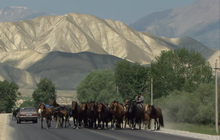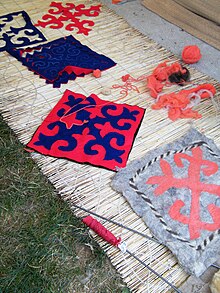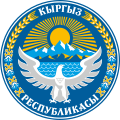Culture of Kyrgyzstan
This article includes a improve this article by introducing more precise citations. (June 2015) ) |
| Part of a series on the |
| Culture of Kyrgyzstan |
|---|
 |
|
People |
| Languages |
|
Cuisine |
| Religion |
|
Art |
| Music |
|
Sport |

The culture of Kyrgyzstan has a wide mix of ethnic groups and cultures, with the
Languages
This section is about an event or subject that may not be current but does not specify the time period. |
Kyrgyzstan is the only former Soviet Central Asian republic to start out with two
campaign was established to make the latter the official national language in all commercial and government uses by 1997; Russian is still used extensively, and the non-Kyrgyz population, most not Kyrgyz speakers, are hostile to forcible Kyrgyzification.Kyrgyzstan has a high
Demographics
In 1992, the population of Kyrgyzstan was estimated as being 53% ethnic
Literary works

Textiles

Traditionally manufactured
Kalpaks are the Kyrgyz national hat, also almost always made of felt.
Colors and designs are chosen to symbolize Kyrgyz traditions and rural life. Flowers, plants, animals, stylized horns, national designs, and emblems of Kyrgyz life are often found in these ornate and colorful embroideries. Designs are sometimes dated and signed by the artist upon completion of the work, which may take years to finish. The tush kiyiz is hung in the yurt, over the marriage bed of the couple, and symbolize their pride in their Kyrgyz tradition.
Cuisine
The cuisine of Kyrgyzstan is similar in many respects to that of its neighbors. Traditional Kyrgyz food revolves around
Kyrgyzstan is home to many different nationalities and their various cuisines. In larger cities, such as Bishkek, Osh, Jalal-Abad, and Karakol, various national and international cuisines can be found. On the road and in the villages, the cuisine tends to be standard Kyrgyz dishes, liberally flavored with oil or sheep fat, which are considered both delicious and healthy by the local population.
Pilaf (paloo) is the national dish in Kyrgyzstan. Green tea is considered the national beverage.
Traditions
Illegal, but still practiced, is the tradition of bride kidnapping.
See also
- Media of Kyrgyzstan
- Music of Kyrgyzstan
- LGBT rights in Kyrgyzstan (Gay rights)
- Islam in Kyrgyzstan
- Christianity in Kyrgyzstan
- Scouting in Kyrgyzstan
- Bergtal
- Tourism in Kyrgyzstan
- Horses in Kyrgyzstan
References
- Handrahan, Lori. 2004. "Hunting for Women: Bride-Kidnapping in Kyrgyzstan." International Feminist Journal of Politics, 6:2 (June), 207–233.
- Kleinbach, Russell. "Frequency of non-consensual bride kidnapping in the Kyrgyz Republic." International Journal of Central Asian Studies. Vol 8, No 1, 2003, pp 108–128.
- ——, Mehrigiul Ablezova and Medina Aitieva. "Kidnapping for marriage (ala kachuu) in a Kyrgyz village." Central Asian Survey. (June 2005) 24(2), 191–202.
- ISBN 1350143685.
- ISBN 978-0-691-11775-1.
- ^ "Ala-kiyiz and Shyrdak, art of Kyrgyz traditional felt carpets | Silk Roads Programme". en.unesco.org. Retrieved 11 December 2022.
- ^ Chochunbaeva, Dinara (14 September 2019). "Shyrdak: A sunny day in Kyrgyzstan | Garland Magazine". garlandmag.com. Retrieved 11 December 2022.
External links
PBS Frontline/World documentary and related pages. The Kidnapped Bride March 2004
This article contains some text originally adapted from the public domain

